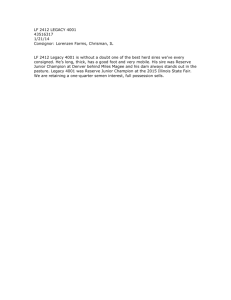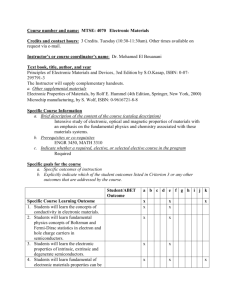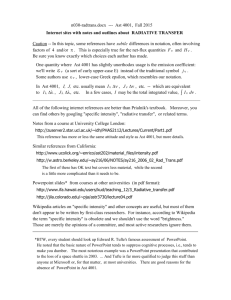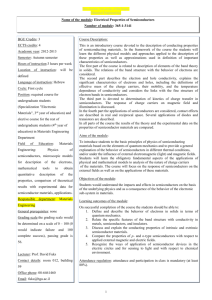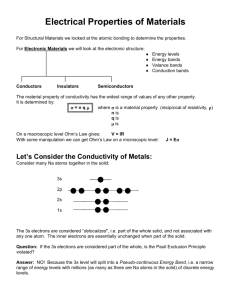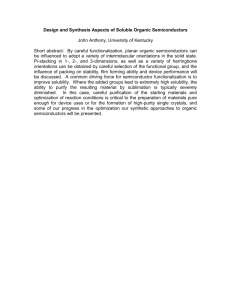Chapter 19 Electronic Materials We need some definitions for electrical resistivity and conductivity
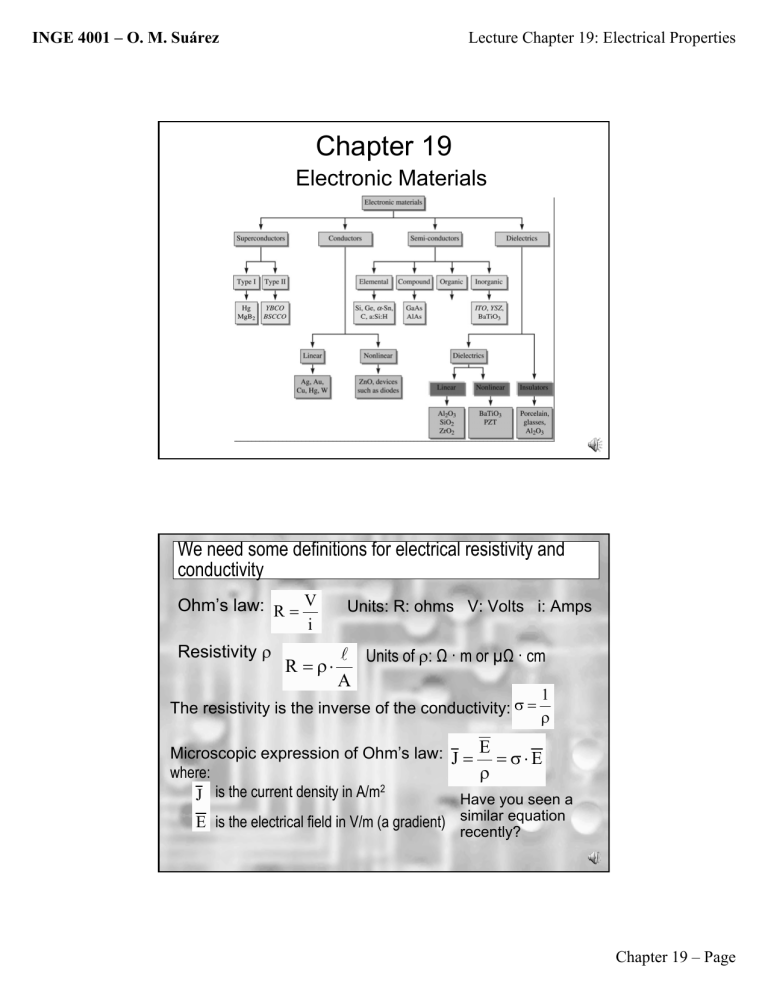
INGE 4001 – O. M. Suárez Lecture Chapter 19: Electrical Properties
Chapter 19
Electronic Materials
We need some definitions for electrical resistivity and conductivity
Ohm’s law:
R
=
V i
Units: R: ohms V: Volts i: Amps
Resistivity ρ
R
= ρ ⋅ l Units of ρ : Ω · m or µ Ω · cm
A
The resistivity is the inverse of the conductivity:
σ =
1
ρ
Microscopic expression of Ohm’s law: where:
J is the current density in A/m 2
E is the electrical field in V/m (a gradient)
J
=
E
ρ
= σ ⋅
E
Have you seen a similar equation recently?
Chapter 19 – Page
INGE 4001 – O. M. Suárez Lecture Chapter 19: Electrical Properties v d
Electron Drift Velocity in Metals
= μ ⋅
E
+ drift velocity mobility electrical field
[m/s] [m 2 ·V -1 ·s -1 ] [V/m]
Therefore, the flux of electrons per unit area and unit time is:
J
=
n
⋅
e
⋅
v d e is the electron charge, n is the number of charges (electrons) crossing an area perpendicular to J at a speed of v d
But why some materials conduct electricity better than others?
forming a crystal.
A new concept: Band structure in solids
Effect of
Pauli’s
Exclusion
Principle
Chapter 19 – Page
INGE 4001 – O. M. Suárez Lecture Chapter 19: Electrical Properties
So, according to Pauli’s exclusion principle, no two electrons can share the same energy level unless they have opposed spins (i.e. m s
= +½, -½)
For one and four sodium atoms:
For one, two and N atoms of Mg:
Electrons cannot share the exact same energy level and need to be distributed in zillion levels forming bands rather than individual levels.
The energy curves transform into bands for the outermost electrons:
For carbon as diamond
For sodium
Hybridization and proximity are responsible for this behavior
Now, because of Pauli’s principle the electrons will have to distribute in bands of energy!
Sodium is a metal conductor but diamond is not. So conductivity is defined by the relation between electrons in the valence and in the conduction band
Chapter 19 – Page
INGE 4001 – O. M. Suárez Lecture Chapter 19: Electrical Properties
Then the differences in band energies answer our question about materials with different resistivities.
Lots of
Now the gap between bands energy
Note the superposition
Reason for the high under certain conditions conduction band
Let’s first talk about good electrical conductors
Metals are the best examples of good electrical conductors:
The electrical resistivity can go from 1.48 µ Ω ·cm for Ag to 50
µ Ω ·cm in stainless steels.
In pure metals:
ρ total
= ρ
T
+ ρ r
(approx.)
Drifting electrons are affected by phonons (elastic waves thermally excited)
Æ more temperature Æ more obstacles for electron movement
Æ higher resistivity
Homework: Look for a good (and understandable) definition of phonons).
Chapter 19 – Page
INGE 4001 – O. M. Suárez Lecture Chapter 19: Electrical Properties
More on the Temperature Effect on the
Electrical Resistivity of Metals
At higher temperatures there is an approximate linear dependence:
ρ
T
= ρ
0ºC
+ α
T
·T where α
T is the temperature coefficient of resistivity and T is the temperature in ºC.
Temperature is not the only factor interacting with phonons.
Impurities are also hurdles for phonons as we’ll see next.
Mathiessen’s Rule describes the additive nature of the resistivity of metals
Effect of deformation
Effect of impurities
Effect of temperature
ρ total
= ρ
Temperature
+ ρ
Impurities
+ ρ deformation
Chapter 19 – Page
INGE 4001 – O. M. Suárez Lecture Chapter 19: Electrical Properties
As the number of phonons increases with temperature, the electrical resistivity of conductors (metals) increases too.
At very low temperatures (close to 0K) there are two possibilities
Possibility I
The metal becomes a superconductor
(negligible resistivity)
Modern superconductors are not metals but “weird” ceramics
YBa
2
Cu
3
O
7 or YBCO
It has a perovskite crystal structure (like
BaTiO
3
) and is
“oxygen deficient.”
How does T c vary as a function of the amount of oxygen?
Chapter 19 – Page
INGE 4001 – O. M. Suárez Lecture Chapter 19: Electrical Properties
Another More Recent Example
Nagamatsu et al . announced the discovery of superconductivity in magnesium diboride (MgB
2
) in the journal Nature in March 2001
Meissner Effect in Superconductors
Applied magnetic field is represented by the red lines; the denser the lines, the stronger the field.
Superconducting phase (T<T c
) exclude the magnetic field (only a very thin surface layer is penetrated) This allows for levitation!!
At T c the mixed phase the field can penetrate the bulk of the superconductor, but is still weakened inside.
At T>T
C
(superconductivity is destroyed) the material is penetrated more or less uniformly by the applied magnetic field.
Chapter 19 – Page
INGE 4001 – O. M. Suárez Lecture Chapter 19: Electrical Properties
At low temperature most metals behave differently.
Possibility II
There is a residual
(finite) resistivity.
This is not a superconductor
Let’s introduce the semiconductors
• Intermediate behavior between insulators and conductors.
• Their conductivity is highly dependent on temperature and chemical composition
• Two types:
–Intrinsic semiconductors
–Extrinsic semiconductors
Chapter 19 – Page
INGE 4001 – O. M. Suárez Lecture Chapter 19: Electrical Properties
Intrinsic semiconductors are those where except for temperature there is no external factor affecting their conductivity.
• Elements from Group IV-A (or 14) of the Periodic Table and some compounds.
• Silicon and germanium
• What do they have in common?
material
Si
Ge
GaP
CdS
GaAs band gap (eV)
1.11
0.67
2.25
2.40
1.42
Intrinsic Semiconductors (cont.)
Let’s knock-off an electron from the cubic structure of silicon
Both charges are mobile!!
What would happen if you put an electric field across the silicon piece?
Chapter 19 – Page
INGE 4001 – O. M. Suárez Lecture Chapter 19: Electrical Properties
Intrinsic Semiconductors (cont.)
The negative charges (electrons) are equal in number to the negative charges (holes).
Conductivity of semiconductors can be calculated as:
σ =
n i
⋅
q
⋅
(
μ
n
+ μ
p
) n i
: number of charge carriers (electrons or holes) q: electron or hole charge (1.60·10 -19 Coulombs)
µ n and µ p
: mobilities of electrons and holes, respectively
Intrinsic Semiconductors (cont.)
Remember that temperature measures internal energy.
Conductivity in semiconductors increases with temperature.
Could you explain why semiconductors behave much different from conductors? Think of the energy gaps.
n i
∝
e
−
E g
/ 2 kT
Chapter 19 – Page
INGE 4001 – O. M. Suárez Lecture Chapter 19: Electrical Properties
Intrinsic Semiconductors (cont.)
Since σ is proportional to the number of carriers:
σ = σ
0 e
−
E g
/ 2 kT or ln
σ =
ln
σ
0
−
E g
2 kT
So, how do you measure E g from the graph?
Then what is the difference with metals?
Extrinsic Semiconductors
Let’s intentionally add impurities with a valence of one higher or one lower, to silicon or germanium.
We need to have an excess of electrons or holes by unbalancing the electronic array of the crystal
Look at the periodic table for candidates!
Chapter 19 – Page
INGE 4001 – O. M. Suárez Lecture Chapter 19: Electrical Properties
n-Type Extrinsic Semiconductors
In a silicon lattice we replace one Si atom for a phosphorus atom. What happens to the electrons of the covalent bond?
P belongs to group VA n-Type Extrinsic Semiconductors (cont.)
In the band model, notice how close we are now to the conduction band:
IVA VA
Donor level E g
Empty conduction band e
_ h h
+
+
E
E c
E v
C N
Si P
Ge As
Sn Sb
Full valence band
Chapter 19 – Page
INGE 4001 – O. M. Suárez Lecture Chapter 19: Electrical Properties
p-Type Extrinsic Semiconductors
Now let’s dope Si with boron (valence +3):
B belongs to group IIIA p-Type Extrinsic Semiconductors (cont.)
Now let’s dope Si with boron (valence +3):
IIIA IVA
B C
Al Si
Ga Ge
In Sn
Δ E = E a
- E v
We have reduced the gap size by Δ E
Chapter 19 – Page
INGE 4001 – O. M. Suárez Lecture Chapter 19: Electrical Properties
Effect of Temperature on Extrinsic Semiconductors
At low temp mostly the number of impurities determines the conductivity. Temperature contributes a little more .
This becomes
= −
E a
−
E k for a p-type semiconductor.
v n-type p-type
Effect of Temperature on Extrinsic
Semiconductors (cont.)
At high temp they behave as intrinsic. Temperature provides enough energy for the electrons to jump to the conduction band
Chapter 19 – Page
INGE 4001 – O. M. Suárez Lecture Chapter 19: Electrical Properties
Semiconductor Devices
A p-n diode junction is put together linearly or planarly
(for computer chips)
Silicon is grown as a single crystal. Doping is done with diffusion process (Chapter 5).
Semiconductor Devices (cont.)
A “cat-whisker”diode.
Ohmic contacts (copper) n-type semiconductor p-type semiconductor
Diodes perform as one-way valves in electrical circuits
Current flows this way
Chapter 19 – Page
INGE 4001 – O. M. Suárez Lecture Chapter 19: Electrical Properties
Semiconductor Devices (cont.)
Under zero bias (no external voltage applied) if the diode is shortened there are two small currents (h + and e can reach a dynamic equilibrium
) that
Under forward biased conditions, the p-side is connected to the positive pole (very high current)
Under reverse biased conditions, the p-side is connected to the negative pole (very small current) p-n Junction
Small Resistivity
Large Resistivity
Chapter 19 – Page
INGE 4001 – O. M. Suárez Lecture Chapter 19: Electrical Properties p-n Junction Rectifier (cont.)
Mostly positive current is output by the diode
The rectifier is inserted in series in an
AC circuit
LED (Light
Emitting
Diodes) are another application of p-n junctions
Now recombination is accompanied by a photon emission.
Chapter 19 – Page
INGE 4001 – O. M. Suárez Lecture Chapter 19: Electrical Properties
Other Electrical Properties of Materials:
Ferroelectricity
Let’s review the concept of dipolar moment.
Dipolar moment is due to local unbalance of charges in ionic or covalent molecule or crystal.
Remember: methane (CH
4
) tetrahedron is “chargesymmetric” so there’s no dipole moment.
H
2
O molecule is not, so it forms a dipole:
H
+
O
H
—
Ferroelectrics
Dielectric materials (large resistivity) that experience polarization in the absence of any electric field → strong dipole moments.
Classic example: barium titanate BaTiO
3
At room temp. → slightly asymmetric perovskite structure
Ionic crystal with Ba 2+ , Ti 4+ and O 2ions.
Chapter 19 – Page
INGE 4001 – O. M. Suárez Lecture Chapter 19: Electrical Properties
Barium Titanate
Below 120ºC the crystal is slightly asymmetric causing an spontaneous dipole (polarization).
Neighboring crystals react accordingly
Above 120ºC (Curie temperature) the misalignment ceases.
Piezoelectricity
This results from dielectrics (ceramics) with large induced polarization.
Under pressure, the crystals polarize and create an electric field.
And viceversa, with an applied electric field they react causing a pressure pulse.
Can you think of any use for these materials?
Chapter 19 – Page
INGE 4001 – O. M. Suárez Lecture Chapter 19: Electrical Properties
Piezoelectricity (cont.)
Example: lead zirconate or PZT PbZrO
3 perovskite-type structure).
(also a
Uses of piezoelectric materials: transducers, speakers, ultrasonic probes (to break kidney stones), ultrasonic detectors, actuators, piezoelectric motors, etc.
Chapter 19 – Page
